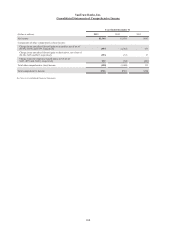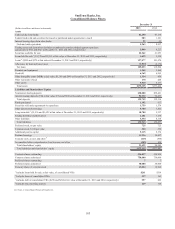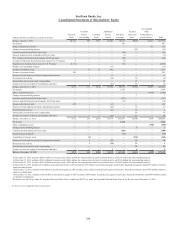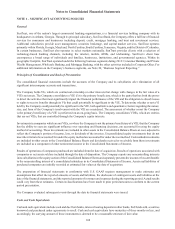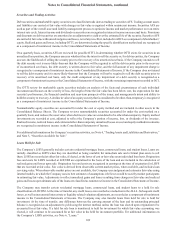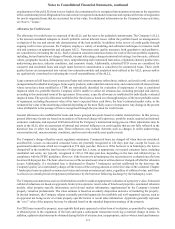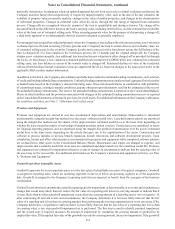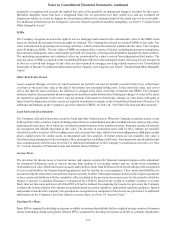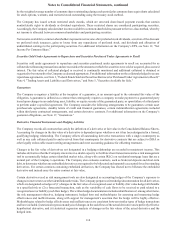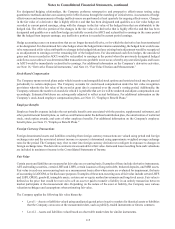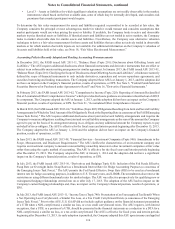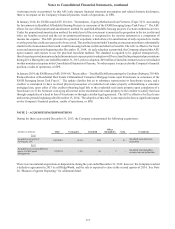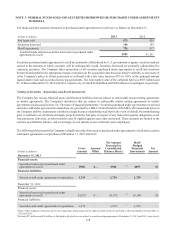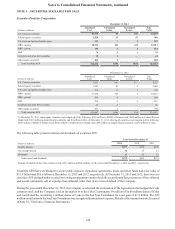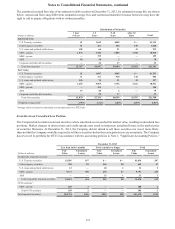SunTrust 2013 Annual Report Download - page 127
Download and view the complete annual report
Please find page 127 of the 2013 SunTrust annual report below. You can navigate through the pages in the report by either clicking on the pages listed below, or by using the keyword search tool below to find specific information within the annual report.Notes to Consolidated Financial Statements, continued
111
an adjustment of the yield. If a loan is never funded, the commitment fee is recognized into noninterest income at the expiration
of the commitment period. Origination fees and costs are recognized in noninterest income and expense at the time of origination
for newly-originated loans that are accounted for at fair value. For additional information on the Company's loans activities,
see Note 6, “Loans.”
Allowance for Credit Losses
The allowance for credit losses is composed of the ALLL and the reserve for unfunded commitments. The Company’s ALLL
is the amount considered adequate to absorb probable current inherent losses within the portfolio based on management’s
evaluation of the size and current risk characteristics of the loan portfolio. In addition to the review of credit quality through
ongoing credit review processes, the Company employs a variety of modeling and estimation techniques to measure credit
risk and construct an appropriate and adequate ALLL. Numerous asset quality measures, both quantitative and qualitative,
are considered in estimating the ALLL. Such evaluation considers numerous factors for each of the loan portfolio segments,
including, but not limited to net charge-off trends, internal risk ratings, changes in internal risk ratings, loss forecasts, collateral
values, geographic location, delinquency rates, nonperforming and restructured loan status, origination channel, product mix,
underwriting practices, industry conditions, and economic trends. Additionally, refreshed FICO scores are considered for
consumer and residential loans and single name borrower concentration is considered for commercial loans. These credit
quality factors are incorporated into various loss estimation models and analytical tools utilized in the ALLL process and/or
are qualitatively considered in evaluating the overall reasonableness of the ALLL.
Large commercial (all loan classes) nonaccrual loans and certain consumer (other direct, indirect, and credit card), residential
(nonguaranteed residential mortgages, home equity products, and residential construction), and commercial (all classes) loans
whose terms have been modified in a TDR are individually identified for evaluation of impairment. A loan is considered
impaired when it is probable that the Company will be unable to collect all amounts due, including principal and interest,
according to the contractual terms of the agreement. If necessary, a specific allowance is established for individually evaluated
impaired loans. The specific allowance established for these loans is based on a thorough analysis of the most probable source
of repayment, including the present value of the loan’s expected future cash flows, the loan’s estimated market value, or the
estimated fair value of the underlying collateral depending on the most likely source of repayment. Any change in the present
value attributable to the passage of time is recognized through the provision for credit losses.
General allowances are established for loans and leases grouped into pools based on similar characteristics. In this process,
general allowance factors are based on an analysis of historical charge-off experience, portfolio trends, regional and national
economic conditions, and expected LGD derived from the Company’s internal risk rating process. Other adjustments may be
made to the ALLL after an assessment of internal and external influences on credit quality that are not fully reflected in the
historical loss or other risk rating data. These influences may include elements such as changes in credit underwriting,
concentration risk, macroeconomic conditions, and/or recent observable asset quality trends.
The Company’s charge-off policy meets regulatory minimums. Commercial loans are charged-off when they are considered
uncollectible. Losses on unsecured consumer loans are generally recognized at 120 days past due, except for losses on
guaranteed student loans which are recognized at 270 days past due. However, if the borrower is in bankruptcy, the loan is
charged-off in the month the loan becomes 60 days past due. Losses, as appropriate, on secured consumer loans, including
residential real estate, are typically recognized at 120 or 180 days past due, depending on the loan and collateral type, in
compliance with the FFIEC guidelines. However, if the borrower is in bankruptcy, the secured asset is evaluated once the loan
becomes 60 days past due. The loan value in excess of the secured asset value is written down or charged-off after the valuation
occurs. Additionally, if a residential loan is discharged in Chapter 7 bankruptcy and not reaffirmed by the borrower, the
Company's policy is to immediately charge-off the excess of the carrying amount over the fair value of the collateral. Chapter
7 bankruptcy loans are placed on nonaccrual status and remain on nonaccrual status, regardless of collateral value, until there
is at least a six month period of repayment performance by the borrower following discharge by the bankruptcy court.
The Company uses numerous sources of information in order to make an appropriate evaluation of a property’s value. Estimated
collateral valuations are based on appraisals, broker price opinions, recent sales of foreclosed properties, automated valuation
models, other property-specific information, and relevant market information, supplemented by the Company’s internal
property valuation professionals. The value estimate is based on an orderly disposition inclusive of marketing the property.
In limited instances, the Company adjusts externally provided appraisals for justifiable and well-supported reasons, such as
an appraiser not being aware of certain property-specific factors or recent sales information. Appraisals generally represent
the “as is” value of the property but may be adjusted based on the intended disposition strategy of the property.
For CRE loans secured by property, an acceptable third party appraisal or other form of evaluation, as permitted by regulation,
is obtained prior to the origination of the loan and upon a subsequent transaction involving a material change in terms. In
addition, updated valuations may be obtained during the life of a transaction, as appropriate, such as when a loan's performance





